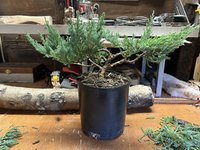If you are interested an excellent resource for Junipers is the book " Masters Series Junipers " Bonsai Today. Was available through Stone Lantern Publishing. The focus is on growing & styling juniper bonsai. Shimpaku, Needle, Procumbens, California and other junipers.
Frank beat me to it but I was about to recommend this and a couple other books!
I just organized my bookshelf--proof that we both had some great plans for Friday note, by my style--and was going to briefly talk about each of them. Most are from Stone Lantern who is ALWAYS running sales and i can recommend as an online store in addition to their role as a bonsai publisher.
In order of how much I like/recommend them:
Principles of Bonsai Design by David de Groot
Truly a masterpiece, and considered by many the most complete book on the art of bonsai design and display. Won't tell you much about technical or horticultural aspects of bonsai, so I'd recommend having another book when starting out, but for what it does, it's hard to beat.
Bonsai Today Masters' Series Junipers/Pines
Nothing more to add; get the junipers one, then grab the pines one once you want to get a pine
 Foundations of Bonsai by Harry Harrington
Foundations of Bonsai by Harry Harrington
Really solid all encompassing book. There's a few things that seem off to me, like recommending auto-watering systems, but like anything, you'll find a mix of things that work for people. (aside: always be questioning if advice people give you makes sense. plurality of opinions is key)
The Little Book of Bonsai
This one might be higher when I finish getting through it. I was too transfixed with the photography and trees to really read it. Just kidding, I've used as a reference on sections, but having read it cover to cover yet. But I do love this one for it's superb trees and photography, which is one of the most important things.
Introduction to Bonsai by the editors of Bonsai Sekai
My first bonsai book, and an interesting one. It has a brief primer on somewhat scattered technique and anesthetics. Its organized as a species guide in the back half, with fully illustrated little articles (reprints from old magazines? I'm unsure) and breif care details. I wouldn't highly recommend it, as it tells you a lot of WHAT to do and no WHY you would do it in the first place, but still worth it since I found at Uwajimaya of all places.
Bonsai: 101 Essential Tips by Harry Tomlinson
I got this for $5 and don't even feel it was worth that. Most the trees are ugly and poorly photographed, and the organization really doesn't make sense. The "tips" are a mix of info and technique, both of which are a mixed bag.
Also in my collection is
Trees of Washington, published by the Wazzu Extension School, and
The Reference Manual of Woody Plant Propagation by Dirr and Heuser. The former is a MUST HAVE if you want to identify native trees. and it's $9, which is probably not more than the price to print and distribute it. (I'm a big fan of our public universities). I found mine at REI which felt very cool cause I'll definitely take it on hikes.
This ended up being a long post, but I'd also recommend at least one book that's just a collection of really beautiful trees. I have a book of Kokufu winners from when I went to Japan, but there's plenty of other ones, and lots of times big shows will publish free online versions which are also good. They have a bunch of these at the bonsai museum.



